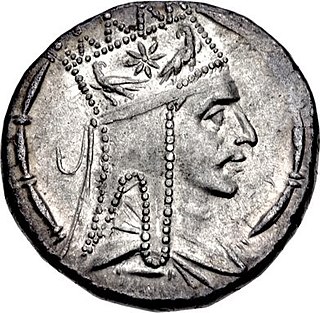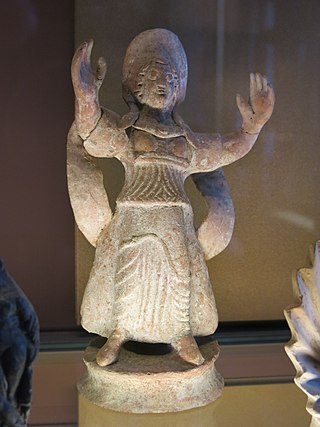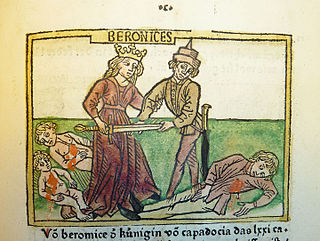
Tigranes II, more commonly known as Tigranes the Great, was a king of Armenia. A member of the Artaxiad dynasty, he ruled from 95 BC to 55 BC. Under his reign, the Armenian kingdom expanded beyond its traditional boundaries and reached its peak, allowing Tigranes to claim the title Great King or King of Kings. His empire for a short time was the most powerful state to the east of the Roman Republic. The appearance of Halley's comet during his reign, as depicted on the rare series of Tigranes's coins, was seen as an auspicious sign.

Pharnaces II of Pontus was the king of the Bosporan Kingdom and Kingdom of Pontus until his death. He was a monarch of Persian and Greek ancestry. He was the youngest child born to King Mithridates VI of Pontus from his first wife, his sister Queen Laodice. He was born and raised in the Kingdom of Pontus and was the namesake of his late double great grandfather Pharnaces I of Pontus. After his father was defeated by the Romans in the Third Mithridatic War and died in 63 BC, the Romans annexed the western part of Pontus, merged it with the former Kingdom of Bithynia and formed the Roman province of Bithynia and Pontus. The eastern part of Pontus remained under the rule of Pharnaces as a client kingdom until his death.

The Mithridatic Wars were three conflicts fought by the Roman Republic against the Kingdom of Pontus and its allies between 88 – 63 BCE. They are named after Mithridates VI, the King of Pontus during the course of the wars who initiated the hostilities with Rome. Mithridates lead the Pontic forces in every war. The Romans would be lead by various generals and consuls throughout the wars, namely Lucius Cornelius Sulla, Lucius Licinius Lucullus, and Gnaeus Pompey Magnus.

The Third Mithridatic War, the last and longest of the three Mithridatic Wars, was fought between Mithridates VI of Pontus and the Roman Republic. Both sides were joined by a great number of allies, dragging the entire east of the Mediterranean and large parts of Asia into the war. The conflict ended in defeat for Mithridates; it ended the Pontic Kingdom and the Seleucid Empire, and also resulted in the Kingdom of Armenia becoming an allied client state of Rome.

Mithridates or Mithradates V Euergetes was a prince and the seventh king of the Kingdom of Pontus.

Berenice or Laodice of Cappadocia, also known as Laodice was a princess from the Kingdom of Pontus and a queen of the Kingdom of Cappadocia by marriage to Ariarathes VI, and queen of Bithynia by marriage to Nicomedes III. She was regent of Cappadocia in 116 BC during the minority of her son Ariarathes VII.

The Battle of Artaxata was fought near the Arsanias River in 68 BC between an army of the Roman Republic and the army of the Kingdom of Armenia. The Romans were led by proconsul Lucius Licinius Lucullus, while the Armenians were led by Tigranes II of Armenia, who was sheltering Mithridates VI of Pontus. The battle was part of the Third Mithridatic War, and was a Roman victory.

Mithridate, also known as mithridatium, mithridatum, or mithridaticum, is a semi-mythical remedy with as many as 65 ingredients, used as an antidote for poisoning, and said to have been created by Mithridates VI Eupator of Pontus in the 1st century BC. It was one of the most complex and highly sought-after drugs during the Middle Ages and Renaissance, particularly in Italy and France, where it was in continual use for centuries. An updated recipe called theriac was known well into the 19th century.
Cleopatra of Pontus was a Pontian princess and a queen consort of Armenia.

The Asiatic Vespers refers to the massacres of Roman and other Latin-speaking peoples living in parts of western Anatolia c. early 88 BC by forces loyal to Mithridates VI Eupator, ruler of the Kingdom of Pontus, who orchestrated the massacre in an attempt to rid Asia Minor of Roman influence. An estimated 80,000 people were killed during the episode. The incident served as the casus belli or immediate cause of the First Mithridatic War between the Roman Republic and the Kingdom of Pontus.

Pontus was a Hellenistic kingdom centered in the historical region of Pontus in modern-day Turkey, and ruled by the Mithridatic dynasty of Persian origin, which possibly may have been directly related to Darius the Great of the Achaemenid dynasty. The kingdom was proclaimed by Mithridates I in 281 BC and lasted until its conquest by the Roman Republic in 63 BC. The Kingdom of Pontus reached its largest extent under Mithridates VI the Great, who conquered Colchis, Cappadocia, Bithynia, the Greek colonies of the Tauric Chersonesos, and for a brief time the Roman province of Asia. After a long struggle with Rome in the Mithridatic Wars, Pontus was defeated.

Mithridates or Mithradates VI Eupator was the ruler of the Kingdom of Pontus in northern Anatolia from 120 to 63 BC, and one of the Roman Republic's most formidable and determined opponents. He was an effective, ambitious and ruthless ruler who sought to dominate Asia Minor and the Black Sea region, waging several hard-fought but ultimately unsuccessful wars to break Roman dominion over Asia and the Hellenic world. He has been called the greatest ruler of the Kingdom of Pontus. He cultivated an immunity to poisons by regularly ingesting sub-lethal doses; this practice, now called mithridatism, is named after him. After his death, he became known as Mithridates the Great.
Dynamis, nicknamed Philoromaios, was a Roman client queen of the Bosporan Kingdom during the Late Roman Republic and part of the reign of Augustus, the first Roman Emperor. Dynamis is an ancient Greek name which means the “powerful one”. She was a monarch of Iranian and Greek Macedonian ancestry. She was the daughter of King Pharnaces II of Pontus and his Sarmatian wife. She had an older brother called Darius and a younger brother called Arsaces. Her paternal grandparents had been the monarchs of the Kingdom of Pontus, Mithridates VI of Pontus and his first wife Laodice, who was also his sister. Dynamis married three times. Her husbands were Asander, a certain Scribonius and Polemon I of Pontus. According to Rostovtzeff, she also had a fourth husband, Aspurgos.
Marcus Marius was a quaestor of the Roman Republic in 76 BC and proquaestor under Quintus Sertorius's government in exile in Spain. Marius was sent by Sertorius to Mithradates of Pontus as an advisor and military commander in the Third Mithridatic War. He is named as or more likely confused with a Varius in Appian.
Laodice VI was a Greek Seleucid princess and through marriage was a queen of the Kingdom of Pontus.
The Battle of Zela, not to be confused with the more famous battle in 47 BC, was fought in 67 BC near Zela in the Kingdom of Pontus. The battle resulted in a stunning Pontic victory and King Mithridates' successful reclamation of his kingdom. Mithridates' victory was short-lived however, as within a few years he would be completely defeated by Pompey the Great.
Monime, sometimes known as Monima, was a Macedonian Greek noblewoman from Anatolia and one of the wives of King Mithridates VI of Pontus.
Orsabaris, also spelt as Orsobaris was a Princess of the Kingdom of Pontus. She was a Queen of Bithynia by marriage to Socrates Chrestus and later married to Lycomedes of Comana.
Çayıryolu, formerly Sünür, is a village in the Bayburt District, Bayburt Province, Turkey. Its population is 231 (2021). Before the 2013 reorganisation, it was a town (belde). The village has a historic mosque and mausoleum.
Mithridates was a son of King Mithridates VI of Pontus and his sister-wife Laodice. He was made by his father ruler of Colchis on the Black Sea, but then removed and put to death on suspicion of disloyalty.










